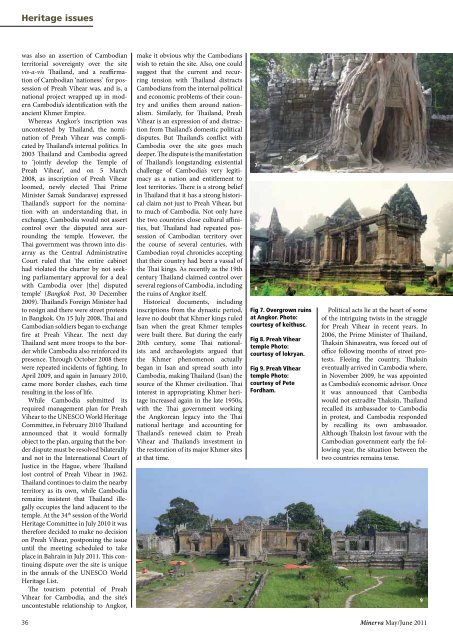Cult of beauty - Minerva
Cult of beauty - Minerva
Cult of beauty - Minerva
Create successful ePaper yourself
Turn your PDF publications into a flip-book with our unique Google optimized e-Paper software.
Heritage issues<br />
was also an assertion <strong>of</strong> Cambodian<br />
territorial sovereignty over the site<br />
vis-a-vis Thailand, and a reaffirmation<br />
<strong>of</strong> Cambodian ‘nationess’ for possession<br />
<strong>of</strong> Preah Vihear was, and is, a<br />
national project wrapped up in modern<br />
Cambodia’s identification with the<br />
ancient Khmer Empire.<br />
Whereas Angkor’s inscription was<br />
uncontested by Thailand, the nomination<br />
<strong>of</strong> Preah Vihear was complicated<br />
by Thailand’s internal politics. In<br />
2003 Thailand and Cambodia agreed<br />
to ‘jointly develop the Temple <strong>of</strong><br />
Preah Vihear’, and on 5 March<br />
2008, as inscription <strong>of</strong> Preah Vihear<br />
loomed, newly elected Thai Prime<br />
Minister Samak Sundaravej expressed<br />
Thailand’s support for the nomination<br />
with an understanding that, in<br />
exchange, Cambodia would not assert<br />
control over the disputed area surrounding<br />
the temple. However, the<br />
Thai government was thrown into disarray<br />
as the Central Administrative<br />
Court ruled that ‘the entire cabinet<br />
had violated the charter by not seeking<br />
parliamentary approval for a deal<br />
with Cambodia over [the] disputed<br />
temple’ (Bangkok Post, 30 December<br />
2009). Thailand’s Foreign Minister had<br />
to resign and there were street protests<br />
in Bangkok. On 15 July 2008, Thai and<br />
Cambodian soldiers began to exchange<br />
fire at Preah Vihear. The next day<br />
Thailand sent more troops to the border<br />
while Cambodia also reinforced its<br />
presence. Through October 2008 there<br />
were repeated incidents <strong>of</strong> fighting. In<br />
April 2009, and again in January 2010,<br />
came more border clashes, each time<br />
resulting in the loss <strong>of</strong> life.<br />
While Cambodia submitted its<br />
required management plan for Preah<br />
Vihear to the UNESCO World Heritage<br />
Committee, in February 2010 Thailand<br />
announced that it would formally<br />
object to the plan, arguing that the border<br />
dispute must be resolved bilaterally<br />
and not in the International Court <strong>of</strong><br />
Justice in the Hague, where Thailand<br />
lost control <strong>of</strong> Preah Vihear in 1962.<br />
Thailand continues to claim the nearby<br />
territory as its own, while Cambodia<br />
remains insistent that Thailand illegally<br />
occupies the land adjacent to the<br />
temple. At the 34 th session <strong>of</strong> the World<br />
Heritage Committee in July 2010 it was<br />
therefore decided to make no decision<br />
on Preah Vihear, postponing the issue<br />
until the meeting scheduled to take<br />
place in Bahrain in July 2011. This continuing<br />
dispute over the site is unique<br />
in the annals <strong>of</strong> the UNESCO World<br />
Heritage List.<br />
The tourism potential <strong>of</strong> Preah<br />
Vihear for Cambodia, and the site’s<br />
uncontestable relationship to Angkor,<br />
36<br />
make it obvious why the Cambodians<br />
wish to retain the site. Also, one could<br />
suggest that the current and recurring<br />
tension with Thailand distracts<br />
Cambodians from the internal political<br />
and economic problems <strong>of</strong> their country<br />
and unifies them around nationalism.<br />
Similarly, for Thailand, Preah<br />
Vihear is an expression <strong>of</strong> and distraction<br />
from Thailand’s domestic political<br />
disputes. But Thailand’s conflict with<br />
Cambodia over the site goes much<br />
deeper. The dispute is the manifestation<br />
<strong>of</strong> Thailand’s longstanding existential<br />
challenge <strong>of</strong> Cambodia’s very legitimacy<br />
as a nation and entitlement to<br />
lost territories. There is a strong belief<br />
in Thailand that it has a strong historical<br />
claim not just to Preah Vihear, but<br />
to much <strong>of</strong> Cambodia. Not only have<br />
the two countries close cultural affinities,<br />
but Thailand had repeated possession<br />
<strong>of</strong> Cambodian territory over<br />
the course <strong>of</strong> several centuries, with<br />
Cambodian royal chronicles accepting<br />
that their country had been a vassal <strong>of</strong><br />
the Thai kings. As recently as the 19th<br />
century Thailand claimed control over<br />
several regions <strong>of</strong> Cambodia, including<br />
the ruins <strong>of</strong> Angkor itself.<br />
Historical documents, including<br />
inscriptions from the dynastic period,<br />
leave no doubt that Khmer kings ruled<br />
Isan when the great Khmer temples<br />
were built there. But during the early<br />
20th century, some Thai nationalists<br />
and archaeologists argued that<br />
the Khmer phenomenon actually<br />
began in Isan and spread south into<br />
Cambodia, making Thailand (Isan) the<br />
source <strong>of</strong> the Khmer civilisation. Thai<br />
interest in appropriating Khmer heritage<br />
increased again in the late 1950s,<br />
with the Thai government working<br />
the Angkorean legacy into the Thai<br />
national heritage and accounting for<br />
Thailand’s renewed claim to Preah<br />
Vihear and Thailand’s investment in<br />
the restoration <strong>of</strong> its major Khmer sites<br />
at that time.<br />
7<br />
8<br />
Fig 7. Overgrown ruins<br />
at Angkor. Photo:<br />
courtesy <strong>of</strong> keithusc.<br />
Fig 8. Preah Vihear<br />
temple Photo:<br />
courtesy <strong>of</strong> lokryan.<br />
Fig 9. Preah Vihear<br />
temple Photo:<br />
courtesy <strong>of</strong> Pete<br />
Fordham.<br />
6<br />
Political acts lie at the heart <strong>of</strong> some<br />
<strong>of</strong> the intriguing twists in the struggle<br />
for Preah Vihear in recent years. In<br />
2006, the Prime Minister <strong>of</strong> Thailand,<br />
Thaksin Shinawatra, was forced out <strong>of</strong><br />
<strong>of</strong>fice following months <strong>of</strong> street protests.<br />
Fleeing the country, Thaksin<br />
eventually arrived in Cambodia where,<br />
in November 2009, he was appointed<br />
as Cambodia’s economic advisor. Once<br />
it was announced that Cambodia<br />
would not extradite Thaksin, Thailand<br />
recalled its ambassador to Cambodia<br />
in protest, and Cambodia responded<br />
by recalling its own ambassador.<br />
Although Thaksin lost favour with the<br />
Cambodian government early the following<br />
year, the situation between the<br />
two countries remains tense.<br />
9<br />
<strong>Minerva</strong> May/June 2011

















